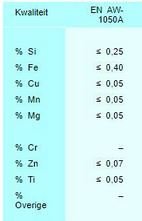reyntjensm
Plastic
- Joined
- Mar 8, 2021
Hello everyone,
I'm trying to mill aluminium sheets(2mm thick) and i'm having issues with sticky chips.
I have to insert some tabs in my milling program. After some tabs the chips build up resulting in a bad finish. I would prefer not to use any liquid cooling since i have a mdf waste board below the aluminium sheets. I use compressed air to blow the chips away. The tool is a single flute PCD tool(5mm) with 900mm/min feed spinning at 18000rpm and 300mm/min plunge rate
I have attached my aluminium specs and a picture of the bad parts. Can anybody help me solve this issue?


I'm trying to mill aluminium sheets(2mm thick) and i'm having issues with sticky chips.
I have to insert some tabs in my milling program. After some tabs the chips build up resulting in a bad finish. I would prefer not to use any liquid cooling since i have a mdf waste board below the aluminium sheets. I use compressed air to blow the chips away. The tool is a single flute PCD tool(5mm) with 900mm/min feed spinning at 18000rpm and 300mm/min plunge rate
I have attached my aluminium specs and a picture of the bad parts. Can anybody help me solve this issue?



